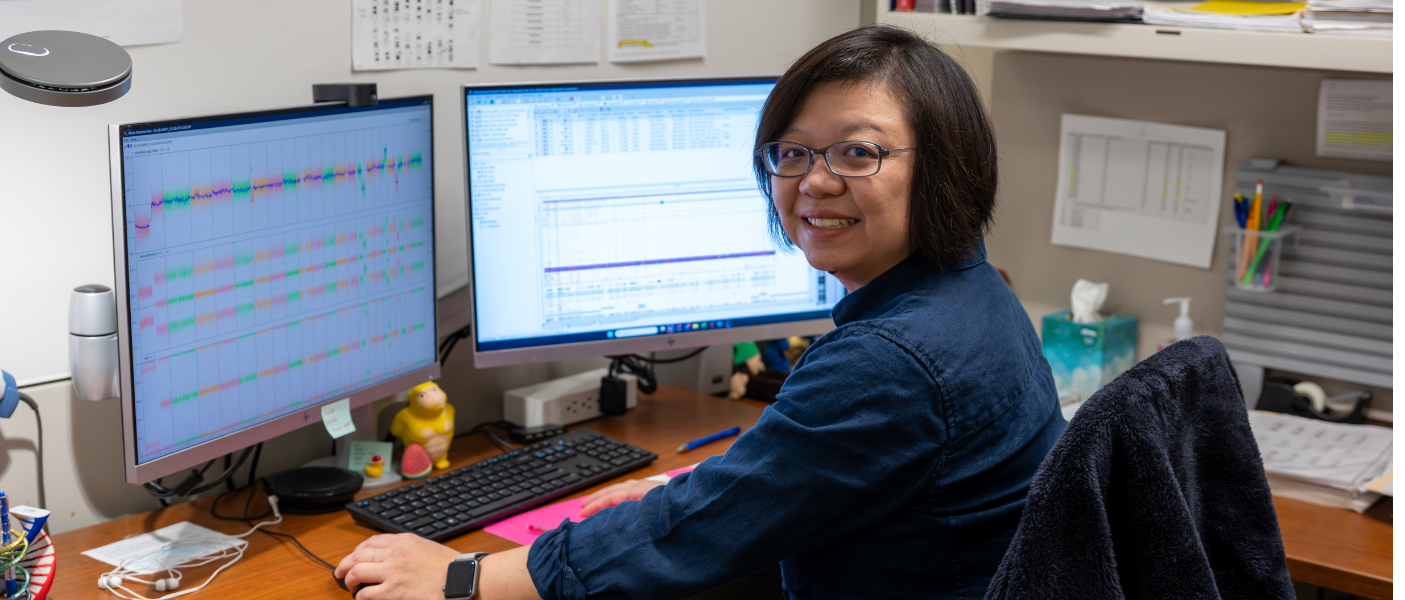

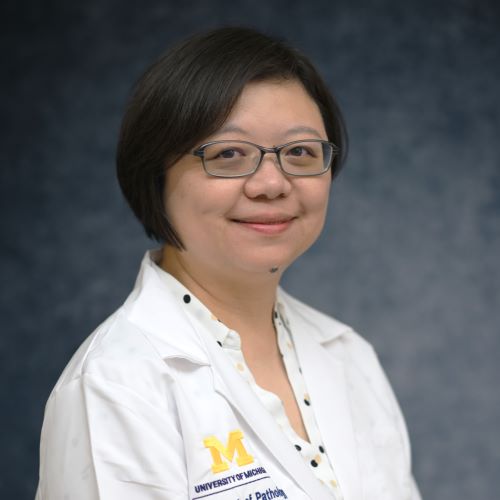
Wang, who is originally from Beijing, China, was fascinated by science, especially biology, growing up, and pursued an undergraduate degree in biological sciences. At this time, she was introduced to molecular biology, genetics, and biotechnology. “I found I was really interested in genetics and molecular biology, and that never changed. Those are my favorite topics.” Following her graduation, she pursued graduate studies at the University of Southern California, where her doctoral research focused on characterizing a group of rare genetic disorders using induced pluripotent stem cells and multi-omic profiling techniques. After earning her PhD, she got an opportunity to work in a biotech start-up with about 30 employees, where she worked in the Research and Development division. In this role, she focused on developing technologies for the detection and visualization of single RNA molecules. “We were able to go down to 50 base pairs, where we could discriminate just a single nucleotide difference. This technology was applied to detect oncogene mutation hotspots in tumor tissue sections.”
This is how Wang became interested in pathology. Pathologists view the morphology, which, when combined with molecular studies, tells the whole story. Wang used the technology to help address scientific or clinical questions and frequently consulted with pathologists. In her role with the start-up company, she also provided tech support, consulted, and talked to scientists and researchers to better understand their needs. Through this process, she met Drs. Arul Chinnaiyan and Rohit Mehra, as they worked together to develop assays.
When Wang’s husband, Dr. Peng Li, was offered a position at the University of Michigan Life Sciences Institute and School of Dentistry about 7.5 years ago, Wang reached out to Chinnaiyan and Mehra and was soon brought on board as a Research Investigator in the Michigan Center for Translational Pathology. “I joined a multidisciplinary team of researchers, physicians, and pathologists to study genitourinary cancer biology, discover and characterize disease biomarkers and therapeutic targets. My colleagues and I established a pipeline for nominating renal cell carcinoma biomarkers using transcriptome data, followed by experimental validation and assay development in clinical specimens. Then the research product was quickly transferred to our clinical laboratory as a clinical test. Here, in the department of Pathology, I witnessed the fast turnaround from concept to a clinical test that assists pathologists in finding a diagnosis for our patients.”
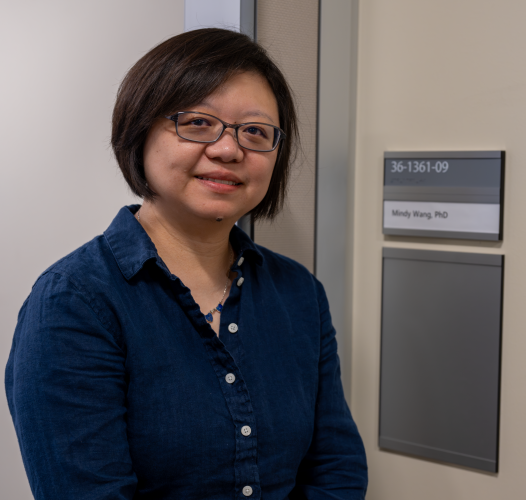 Since coming to Michigan, Wang has been impressed with the motivation and brilliance of her colleagues and the highly collaborative nature of the laboratory. “Each brings their own skills and knowledge, from all over the world. We team up with different people depending on the needs of our projects, and we learn from each other.”
Since coming to Michigan, Wang has been impressed with the motivation and brilliance of her colleagues and the highly collaborative nature of the laboratory. “Each brings their own skills and knowledge, from all over the world. We team up with different people depending on the needs of our projects, and we learn from each other.”
A couple of years ago, Wang learned about the Laboratory Genetics and Genomics (LGG) Fellowship Program, a specialized training program for MDs and PhD scientists who are interested in clinical work and in directing clinical genetics laboratories. Two years ago, she was accepted into the LGG fellowship at the University of Michigan, offered in collaboration with the Departments of Pathology and Pediatrics. “My research interests and my career experience led me into this fellowship.” During her fellowship, Wang trained in both the cytogenetics and the molecular genetics laboratories. “I quickly realized that this was a fantastic place to work. The technologists here are incredibly skillful and supportive of all the trainees. The directors and faculty who trained me were also supportive and deeply knowledgeable. I love the environment, and the longer I am here, the more this impression continues to grow.”
When Wang completed her fellowship, she accepted a position as a clinical assistant professor in the Division of Diagnostic Genetics and Genomics within the Department of Pathology.
“As a clinical laboratory geneticist, I oversee the testing, interpretation, quality, and compliance of laboratory services in both the cytogenetics and molecular genetics laboratories. This includes conventional chromosome analysis, fluorescence in situ hybridization (FISH), chromosomal microarray, next-generation sequencing (NGS)-based tests, and emerging genomic technologies such as optical genome mapping (OGM). These tests play a critical role in the diagnosis of both constitutional and somatic disorders, including hematological malignancies and solid tumors.
Fresh out of training, Wang looks forward to enhancing her skills and confidence across all the assays and responsibilities in her role. She looks forward to teaching other trainees and developing new tests. She thrives on finding answers to puzzling cases. Through it all, she keeps her PhD advisor’s words in mind: “What do the patients and their families really need? How can we help them?” She smiles as she adds, “Sometimes they need help from science — and sometimes they need us to join them for a 5K run.”
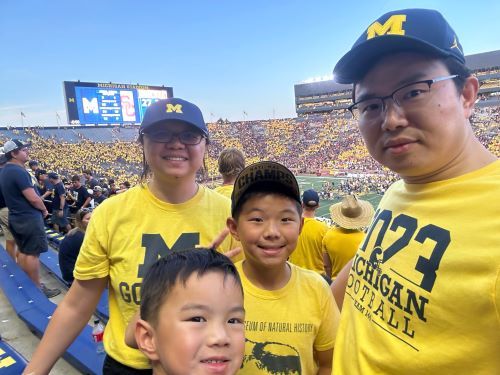 On the personal front, Wang takes great pride and joy in her two sons, Brayden and Darren. “I'm excited to watch them grow and learn new things. A few years ago, my son decided he wanted to learn to ski. I did not know how to ski, but we learned together.” Beyond skiing, Wang loves to cook, bake, and assemble things – whether it be kids’ toys or bookcases. “My mom was an excellent cook, but she did not follow recipes. She would tell me to add some water and some flour until it felt a specific way, but I am a scientist. I follow protocols. I need recipes!” With recipes in hand, Wang loves to try preparing meals from around the world. As a family, they also enjoy traveling and exploring new cities and different kinds of food. “Trying something new is what keeps you young at heart!”
On the personal front, Wang takes great pride and joy in her two sons, Brayden and Darren. “I'm excited to watch them grow and learn new things. A few years ago, my son decided he wanted to learn to ski. I did not know how to ski, but we learned together.” Beyond skiing, Wang loves to cook, bake, and assemble things – whether it be kids’ toys or bookcases. “My mom was an excellent cook, but she did not follow recipes. She would tell me to add some water and some flour until it felt a specific way, but I am a scientist. I follow protocols. I need recipes!” With recipes in hand, Wang loves to try preparing meals from around the world. As a family, they also enjoy traveling and exploring new cities and different kinds of food. “Trying something new is what keeps you young at heart!”
We are thrilled that Dr. Wang is continuing her faculty journey in Pathology. Please be sure to congratulate her when you see her, or stop by to share your favorite recipe.
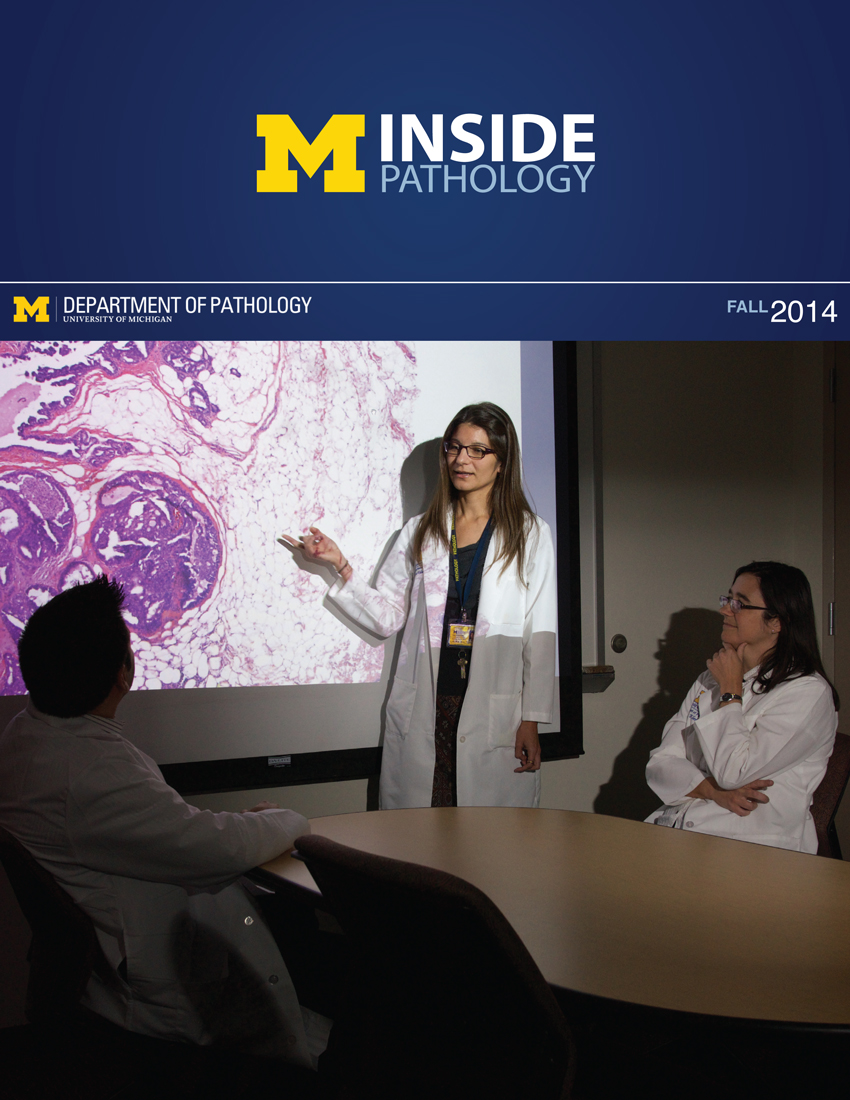 ON THE COVER
ON THE COVER
Breast team reviewing a patient's slide. (From left to right) Ghassan Allo, Fellow; Laura Walters, Clinical Lecturer; Celina Kleer, Professor. See Article 2014Department Chair |

newsletter
INSIDE PATHOLOGYAbout Our NewsletterInside Pathology is an newsletter published by the Chairman's Office to bring news and updates from inside the department's research and to become familiar with those leading it. It is our hope that those who read it will enjoy hearing about those new and familiar, and perhaps help in furthering our research. CONTENTS
|
 ON THE COVER
ON THE COVER
Autopsy Technician draws blood while working in the Wayne County morgue. See Article 2016Department Chair |

newsletter
INSIDE PATHOLOGYAbout Our NewsletterInside Pathology is an newsletter published by the Chairman's Office to bring news and updates from inside the department's research and to become familiar with those leading it. It is our hope that those who read it will enjoy hearing about those new and familiar, and perhaps help in furthering our research. CONTENTS
|
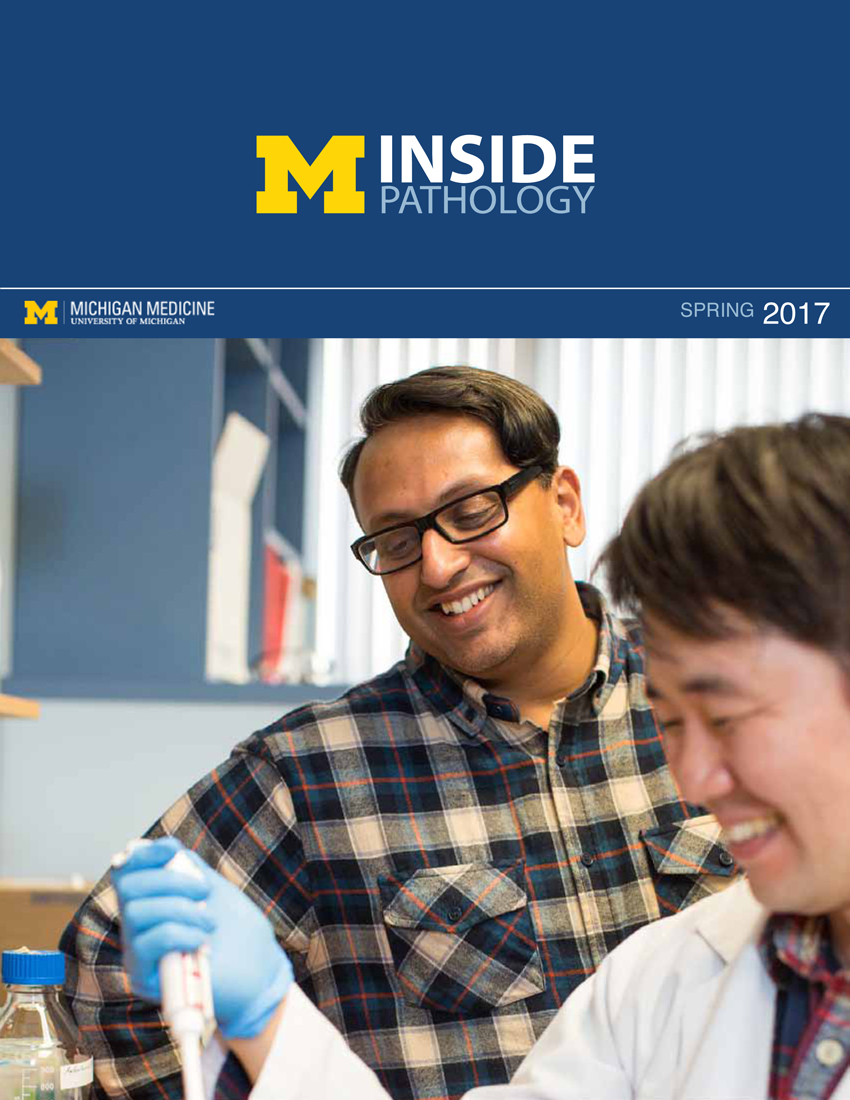 ON THE COVER
ON THE COVER
Dr. Sriram Venneti, MD, PhD and Postdoctoral Fellow, Chan Chung, PhD investigate pediatric brain cancer. See Article 2017Department Chair |

newsletter
INSIDE PATHOLOGYAbout Our NewsletterInside Pathology is an newsletter published by the Chairman's Office to bring news and updates from inside the department's research and to become familiar with those leading it. It is our hope that those who read it will enjoy hearing about those new and familiar, and perhaps help in furthering our research. CONTENTS
|
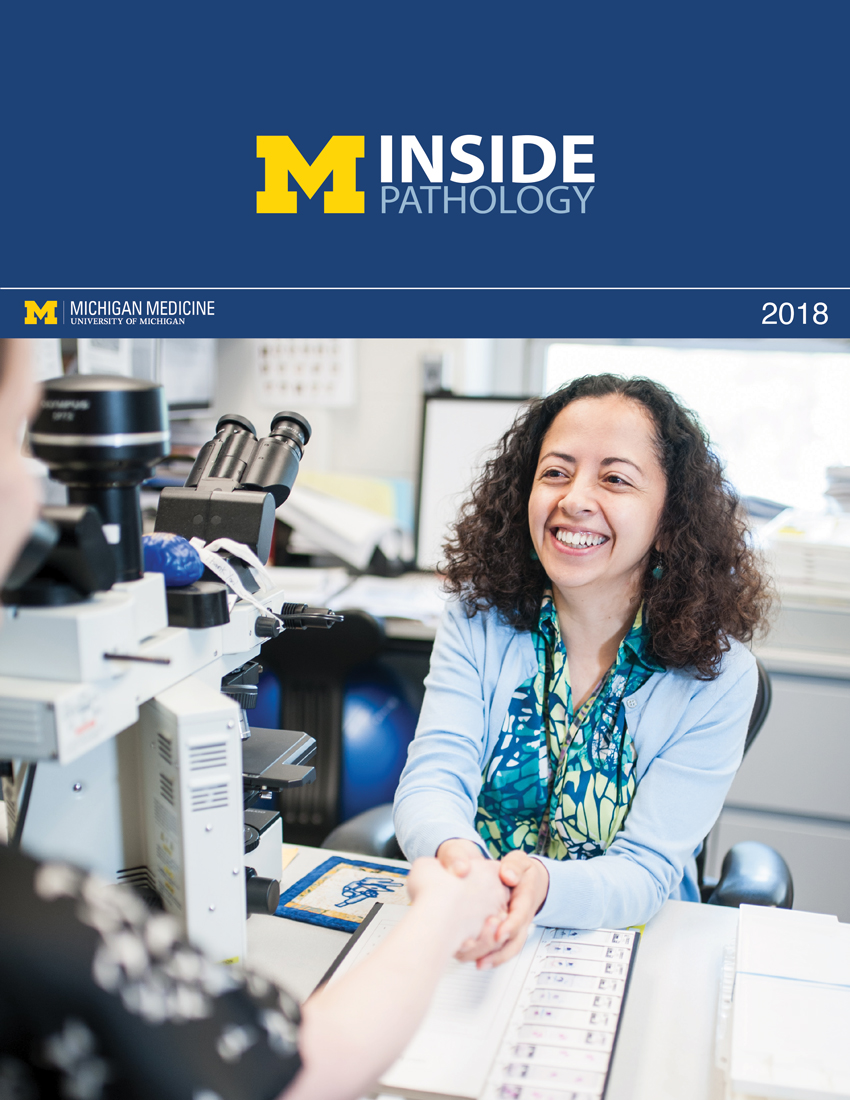 ON THE COVER
ON THE COVER
Director of the Neuropathology Fellowship, Dr. Sandra Camelo-Piragua serves on the Patient and Family Advisory Council. 2018Department Chair |

newsletter
INSIDE PATHOLOGYAbout Our NewsletterInside Pathology is an newsletter published by the Chairman's Office to bring news and updates from inside the department's research and to become familiar with those leading it. It is our hope that those who read it will enjoy hearing about those new and familiar, and perhaps help in furthering our research. CONTENTS
|
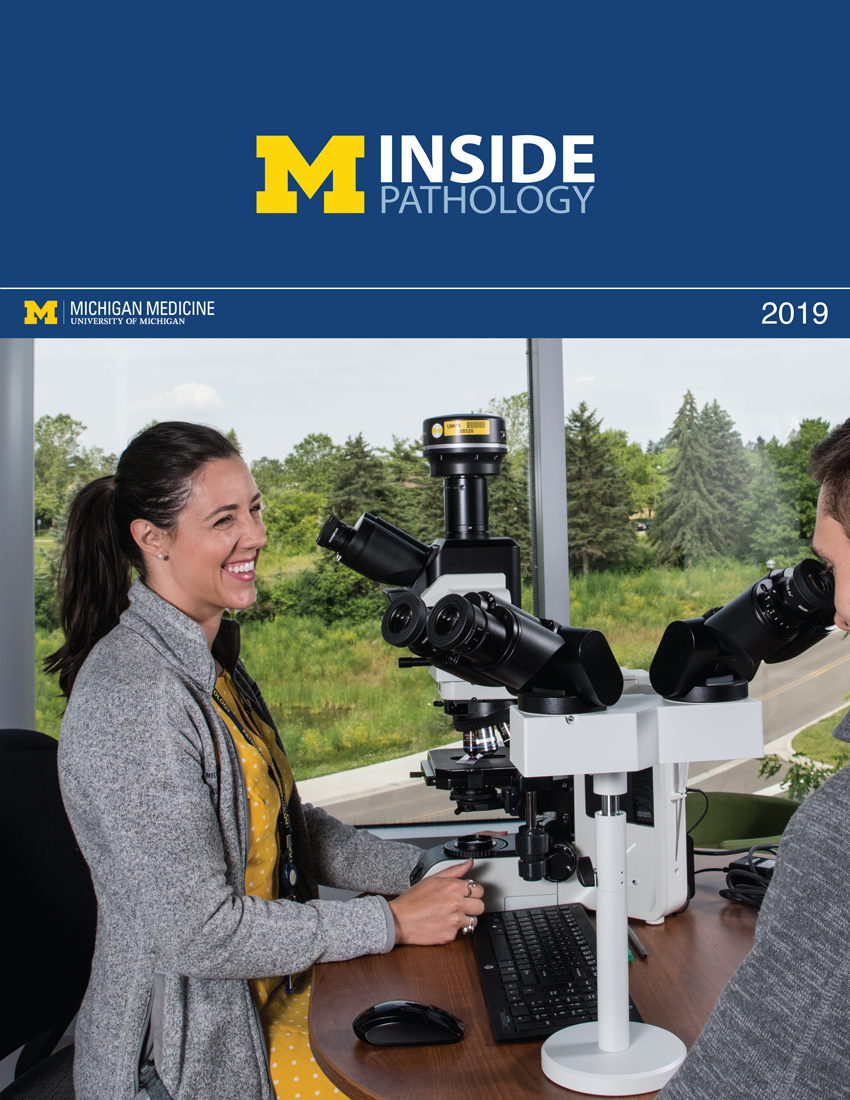 ON THE COVER
ON THE COVER
Residents Ashley Bradt (left) and William Perry work at a multi-headed scope in our new facility. 2019Department Chair |

newsletter
INSIDE PATHOLOGYAbout Our NewsletterInside Pathology is an newsletter published by the Chairman's Office to bring news and updates from inside the department's research and to become familiar with those leading it. It is our hope that those who read it will enjoy hearing about those new and familiar, and perhaps help in furthering our research. CONTENTS
|
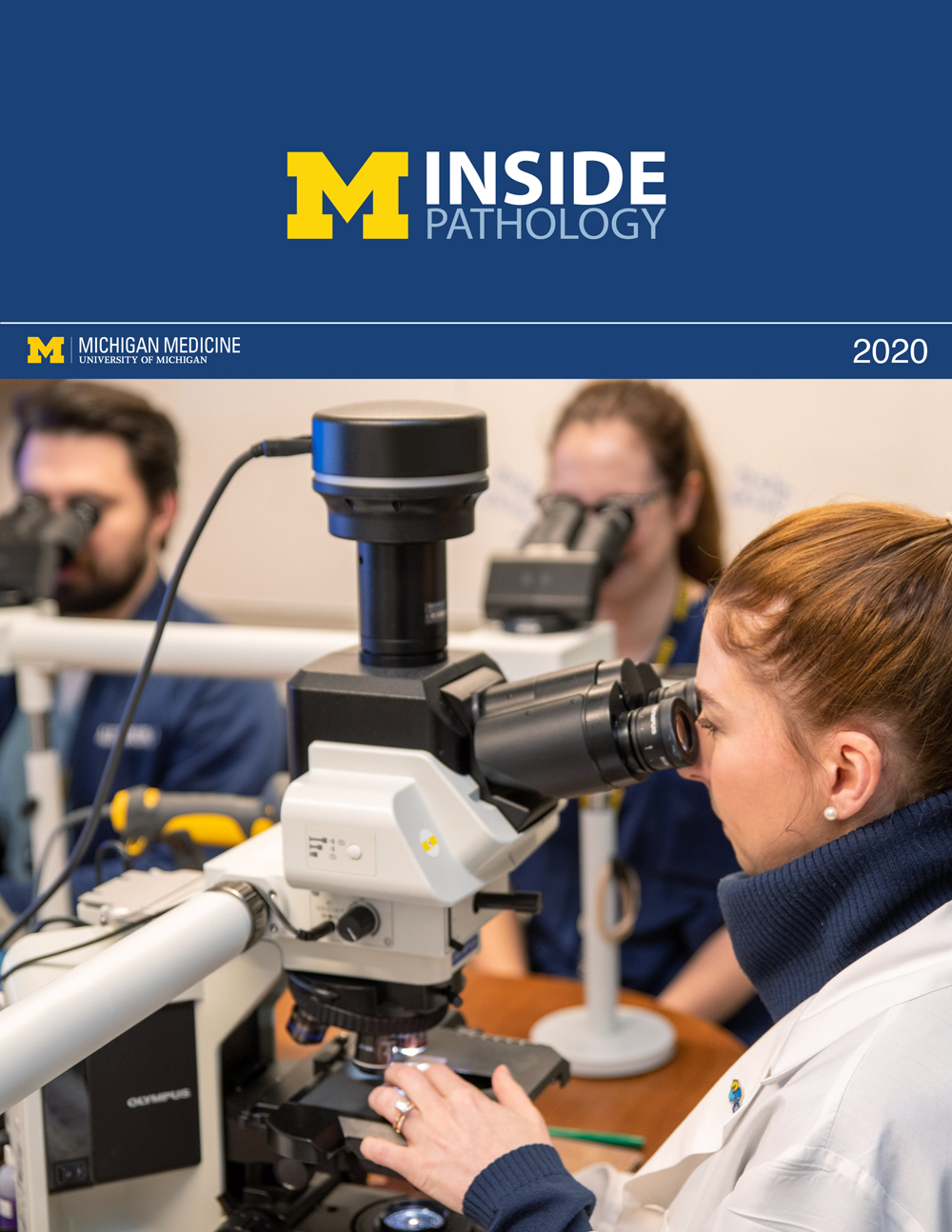 ON THE COVER
ON THE COVER
Dr. Kristine Konopka (right) instructing residents while using a multi-headed microscope. 2020Department Chair |

newsletter
INSIDE PATHOLOGYAbout Our NewsletterInside Pathology is an newsletter published by the Chairman's Office to bring news and updates from inside the department's research and to become familiar with those leading it. It is our hope that those who read it will enjoy hearing about those new and familiar, and perhaps help in furthering our research. CONTENTS
|
 ON THE COVER
ON THE COVER
Patient specimens poised for COVID-19 PCR testing. 2021Department Chair |

newsletter
INSIDE PATHOLOGYAbout Our NewsletterInside Pathology is an newsletter published by the Chairman's Office to bring news and updates from inside the department's research and to become familiar with those leading it. It is our hope that those who read it will enjoy hearing about those new and familiar, and perhaps help in furthering our research. CONTENTS
|
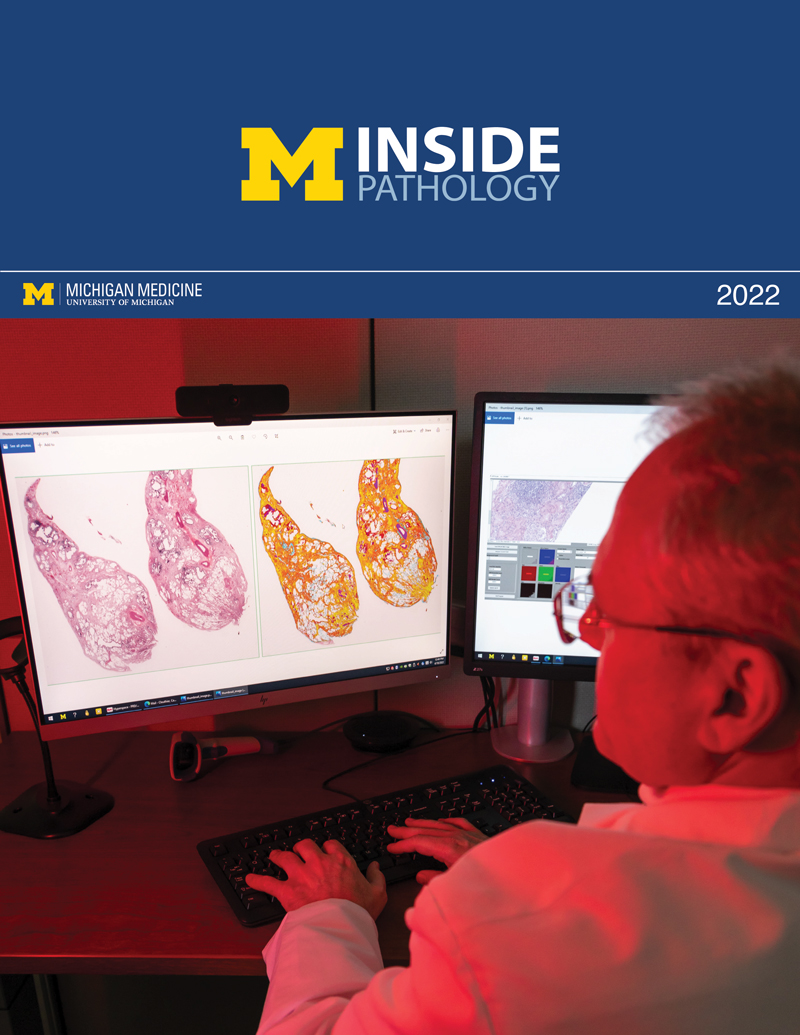 ON THE COVER
ON THE COVER
Dr. Pantanowitz demonstrates using machine learning in analyzing slides. 2022Department Chair |

newsletter
INSIDE PATHOLOGYAbout Our NewsletterInside Pathology is an newsletter published by the Chairman's Office to bring news and updates from inside the department's research and to become familiar with those leading it. It is our hope that those who read it will enjoy hearing about those new and familiar, and perhaps help in furthering our research. CONTENTS
|
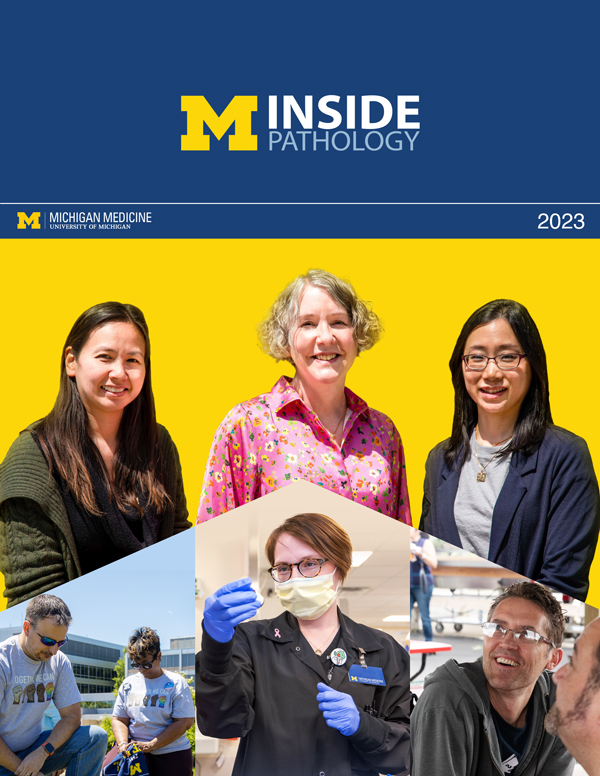 ON THE COVER
ON THE COVER
(Left to Right) Drs. Angela Wu, Laura Lamps, and Maria Westerhoff. 2023Department Chair |

newsletter
INSIDE PATHOLOGYAbout Our NewsletterInside Pathology is an newsletter published by the Chairman's Office to bring news and updates from inside the department's research and to become familiar with those leading it. It is our hope that those who read it will enjoy hearing about those new and familiar, and perhaps help in furthering our research. CONTENTS
|
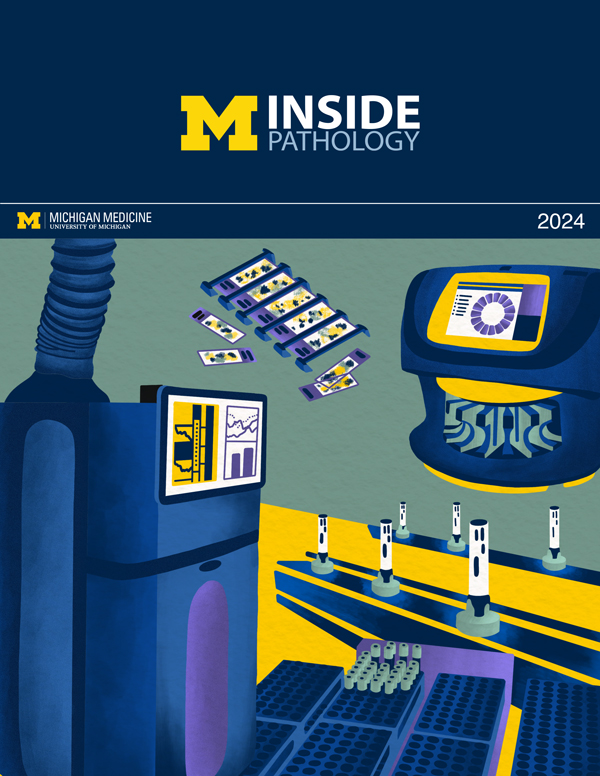 ON THE COVER
ON THE COVER
Illustration representing the various machines and processing used within our labs. 2024Department Chair |

newsletter
INSIDE PATHOLOGYAbout Our NewsletterInside Pathology is an newsletter published by the Chairman's Office to bring news and updates from inside the department's research and to become familiar with those leading it. It is our hope that those who read it will enjoy hearing about those new and familiar, and perhaps help in furthering our research. CONTENTS
|
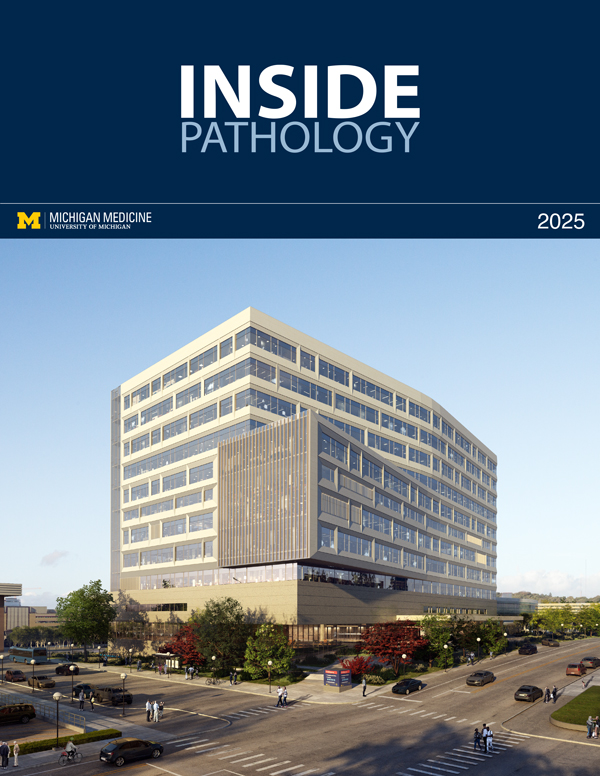 ON THE COVER
ON THE COVER
Rendering of the D. Dan and Betty Khn Health Care Pavilion. Credit: HOK 2025Department Chair |

newsletter
INSIDE PATHOLOGYAbout Our NewsletterInside Pathology is an newsletter published by the Chairman's Office to bring news and updates from inside the department's research and to become familiar with those leading it. It is our hope that those who read it will enjoy hearing about those new and familiar, and perhaps help in furthering our research. CONTENTS
|

MLabs, established in 1985, functions as a portal to provide pathologists, hospitals. and other reference laboratories access to the faculty, staff and laboratories of the University of Michigan Health System’s Department of Pathology. MLabs is a recognized leader for advanced molecular diagnostic testing, helpful consultants and exceptional customer service.